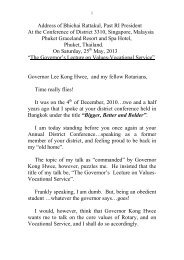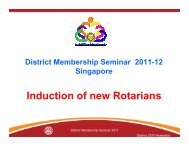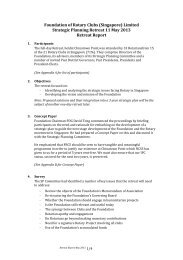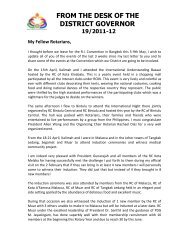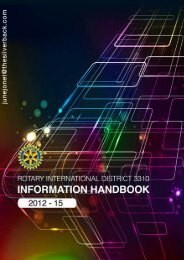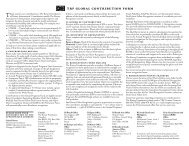haemodialysis_quality_standards - Rotary International District 3310
haemodialysis_quality_standards - Rotary International District 3310
haemodialysis_quality_standards - Rotary International District 3310
Create successful ePaper yourself
Turn your PDF publications into a flip-book with our unique Google optimized e-Paper software.
Foreword<br />
By The<br />
Deputy Director General of Health Malaysia<br />
(Medical)<br />
In Malaysia, the evolution of <strong>haemodialysis</strong> from the short-term therapy for acute renal failure<br />
involving a handful of patients in the sixties has quickly expanded to become the most important<br />
long-term therapy for patients with end stage renal failure.<br />
While the <strong>haemodialysis</strong> service were mainly provided by the public sector in the eighties<br />
and early nineties, this is not the case now. While the density of public <strong>haemodialysis</strong><br />
centres remained static at 5 per million population (pmp) between 2005 to 2010, the private<br />
<strong>haemodialysis</strong> centres doubled from 5 pmp in 2005 to 10pmp in 2010 while the Non-<br />
Governmental Organizations (NGO) centres increased from 4 to 5 pmp over the same period.<br />
Under the Private Healthcare and Facilities Act 1998, <strong>haemodialysis</strong> services in the private<br />
and NGO sectors are subjected to licensing and monitoring so as to ensure that they are<br />
provided to meet the needs of the patients as well as delivered by taking into consideration<br />
basic requirements of safety and <strong>standards</strong>. While the contents of the Act deal with the principle<br />
and basic issues, the Ministry of Health, assisted by the members of the nephrology service has<br />
<br />
ensure that such treatments conform to the required <strong>standards</strong>. In the process of preparing this<br />
document, several public sessions were held with the participation of clinicians and technicians<br />
from both the public and private sector.<br />
As this is a national document, the <strong>standards</strong> and requirements spelt therein will apply equally<br />
to the public, private and NGO facilities.It is my sincere hope that this document will contribute<br />
to better care for patients receiving long-term <strong>haemodialysis</strong> treatment in this country.<br />
Datuk Dr Noor Hisham Bin Abdullah<br />
Haemodialysis Quality and Standards 7



